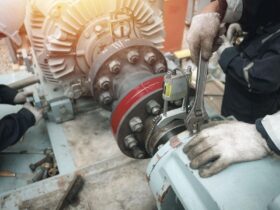Ensuring worker safety in environments where falls are a risk is critical, and fall protection harnesses are a key component in preventing workplace injuries and fatalities. These devices, when used according to ANSI Z359 and OSHA 1910 standards, provide an effective way to safeguard workers from dangerous falls. This guide will walk you through the essentials of fall protection safety harnesses, focusing on ANSI Z359 guidelines and OSHA 1910 regulations to ensure that your workforce is secure and compliant.
What is a Fall Protection Safety Harness?
A fall protection safety harness is a form of personal protective equipment (PPE) designed to prevent workers from falling from heights. The harness distributes the force of impact over a large part of the body, minimizing injury risks. Safety harnesses are crucial in industries like construction, maintenance, oil and gas, and other sectors where fall hazards are present.
Key Components of a Safety Harness
A standard safety harness consists of:
Shoulder Straps – These run over the shoulders and connect to the back D-ring, ensuring even weight distribution.
Leg Straps – Provide support around the thighs, securing the harness on the lower body.
D-Ring – Located at the back, it is the main attachment point for fall arrest systems.
Chest Strap – Prevents the harness from shifting and keeps it in place during a fall.
Each component must be inspected regularly to ensure it’s free from wear or damage that could compromise safety.
ANSI Z359: The Standard for Fall Protection Harnesses
The ANSI Z359 standard, developed by the American National Standards Institute, sets guidelines for fall protection harnesses and other fall protection systems. Here are some key points to remember:
- Materials and Strength: ANSI Z359 specifies the types of materials suitable for harnesses, requiring them to endure significant force without breaking.
- D-Ring Position: The D-ring must be positioned in the center of the back, at shoulder level, to evenly distribute forces in the event of a fall.
- Labeling: The standard requires clear and visible labeling to ensure users understand the harness’s limitations and proper usage.
- Harnesses complying with ANSI Z359 offer reliable fall protection that meets industry standards, providing peace of mind to both workers and employers.
- OSHA 1910: Fall Protection Regulations in the Workplace
The OSHA 1910 standard, enforced by the Occupational Safety and Health Administration (OSHA), governs general industry safety, including fall protection. Key OSHA 1910 requirements for harnesses include:
- Inspection Protocols: Harnesses must be inspected before each use and undergo periodic checks. Damaged harnesses should be replaced immediately.
- Fall Distance and Clearance: OSHA mandates that fall protection systems must prevent workers from hitting any lower level.
- Training: Employers are required to provide fall protection training to ensure that workers can use harnesses correctly and understand their limitations.
By adhering to OSHA 1910 guidelines, employers reduce the risk of accidents and improve compliance, which can help avoid hefty fines.
Choosing the Right Fall Protection Harness
Selecting a harness that meets ANSI Z359 and OSHA 1910 requirements is essential. Here’s a checklist for selecting the best harness:
- Type of Work Environment: Choose a harness based on the specific hazards of your work environment.
- Weight Capacity: Ensure the harness can safely support the weight of the worker, including tools.
- Comfort and Fit: The harness should fit snugly without restricting movement.
- Durability and Material Quality: ANSI-compliant materials ensure durability under harsh conditions.
Inspecting and Maintaining Fall Protection Harnesses
Regular inspection and maintenance are essential to extend the lifespan and effectiveness of a fall protection harness:
- Visual Inspection: Look for frayed straps, broken stitching, rust, or corrosion.
- Functional Check: Ensure all buckles and D-rings are securely fastened.
- Documentation: Keep a log of all inspections and maintenance performed on each harness.
Training Workers on Proper Harness Use
Training is a critical component in effective fall protection. Workers should know how to properly don, adjust, and inspect their harnesses. Training should cover:
- Proper attachment points
- Inspecting harnesses before each use
- Understanding fall distances and anchor points
- Training ensures that workers know how to use their equipment properly, minimizing risk on the job.
- Prioritize Safety with ANSI Z359 and OSHA 1910 Compliant Harnesses
Using a fall protection harness that complies with ANSI Z359 and OSHA 1910 standards is essential for a safe working environment. Regular training, inspections, and adherence to these guidelines will help mitigate fall risks, creating a safer, more productive workplace. Investing in the right harness and fall protection equipment not only saves lives but also demonstrates a commitment to safety and regulatory compliance.









